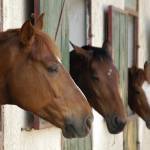Feeding Horses with Gastrointestinal Disorders

Difficult or painful swallowing can reduce feed intake in horses. Some causes of swallowing difficulty include obstruction from abscesses or strangles; nerve damage from equine protozoal myeloencephalitis (EPM) and muscle weakness caused by hyperkalemic periodic paralysis (HYPP); or botulism. Scar tissue from an episode of choking also can cause swallowing difficulty. If the esophagus is narrowed due to scarring from choking, a slurry made from hay cubes and grain may need to be fed.
Gastric ulcers can cause a reduction in appetite. The occurrence of ulcers in horses is high. Surveys put the incidence for racehorses near 90%. In stalled show horses, the frequency approaches 65%. Horses maintained on pasture rarely have ulcers, but when they are confined to stalls and fed grain meals, ulcers can develop within four days. Damage to the nonglandular portion of the stomach by hydrochloric acid produced in the glandular region causes painful lesions that can reduce intake. Signs associated with gastric ulcers are irritability, chronic colic, diarrhea, weight loss, and dull hair coat.
Gastrointestinal disorders in horses can be further divided into those associated with the small intestine including enteropathies, malabsorption syndromes, and small intestine resection, and those involving the large intestine such as colitis, diarrhea, chronic impaction, and colon resection. With small intestinal disease, the primary goal is to optimize the large bowel’s digestive function. This is achieved by feeding highly digestible fiber sources such as leafy alfalfa (lucerne), beet pulp, or soybean hulls while reducing grain. Feeding small meals of highly fermentable fibers (beet pulp and alfalfa), fat (rice bran), and vegetable oil has maintained body condition in horses following resection of 50% of the small intestine. Complete pelleted feeds have been fed in small amounts with positive results even after 70% of distal small intestine resection.
Large intestinal dysfunction usually results in diarrhea. In the acute phase, many affected horses will show inappetence and need enteral nutritional support. Small intestinal function is maintained with large colon resection. Diets that are low in fiber and high in digestible energy and protein should be fed. As the horse’s appetite improves, fermentable fiber should be added. Probiotics and yeast are recommended to help reestablish the gut microflora. Vitamin K and B vitamins should be supplemented because of decreased production in the hindgut. Nutritional support can be provided by parenteral (intravenous) or enteral feeding.
Voluntary feeding is dependent on the condition of the horse and its appetite. Appetite stimulation is often accomplished by “cafeteria-style” feeding in which the horse can select from many options. Lush, green grass is often the most appealing feed for horses. However, mashes, leafy alfalfa, grains, sweet feeds, and fresh fruit may also appeal to a horse when trying to encourage feed consumption.
There are a variety of enteral diets that have been developed for feeding via nasogastric tube. The Naylor diet, composed of alfalfa meal, casein, dextrose, electrolyte mixture, and water, is one of the most widely accepted. It can be fed via a nasal tube in small batches to meet the maintenance energy needs of an adult horse.
Once horses are eating, a simple refeeding program can be put into place.
Read more from Advances in Equine Nutrition IV.








